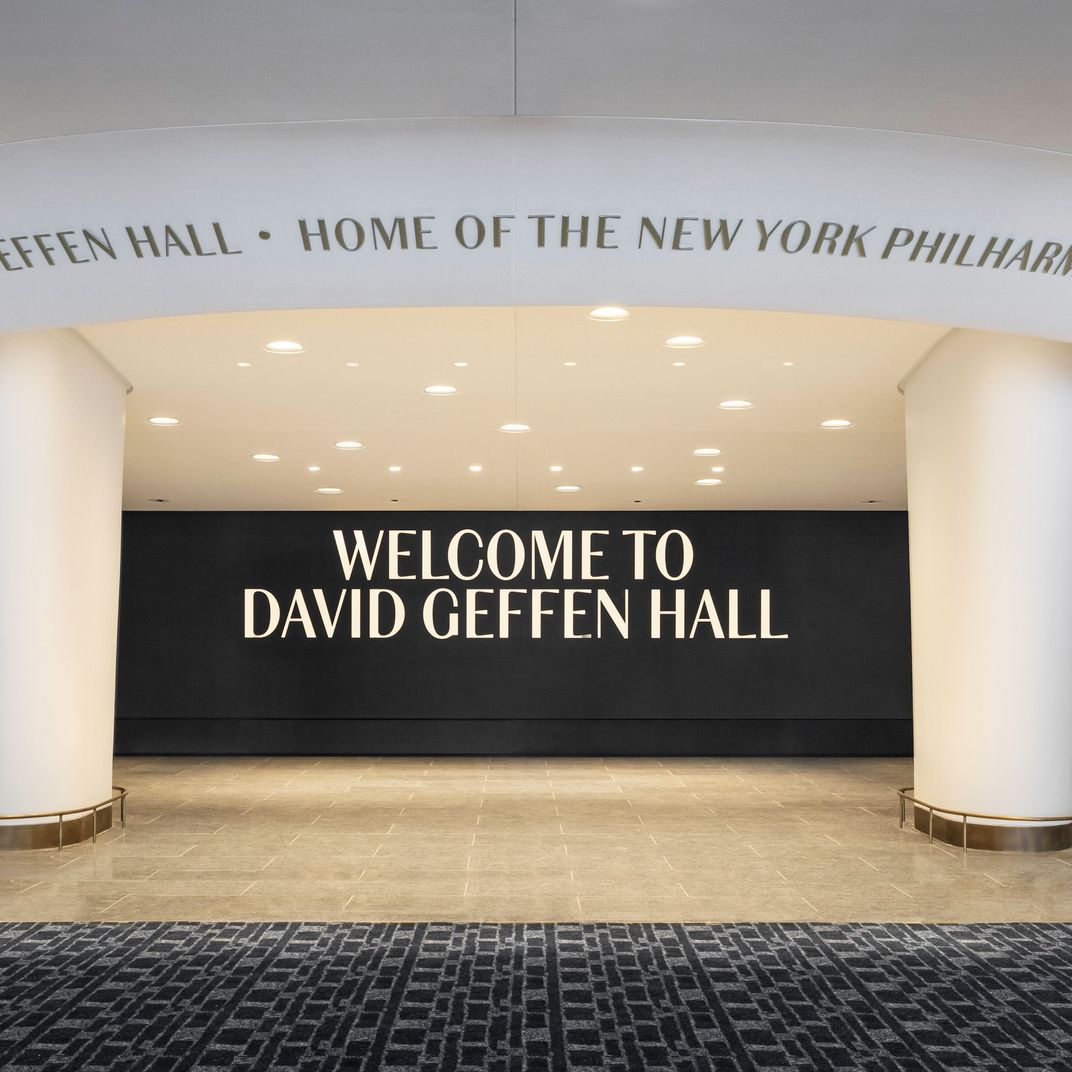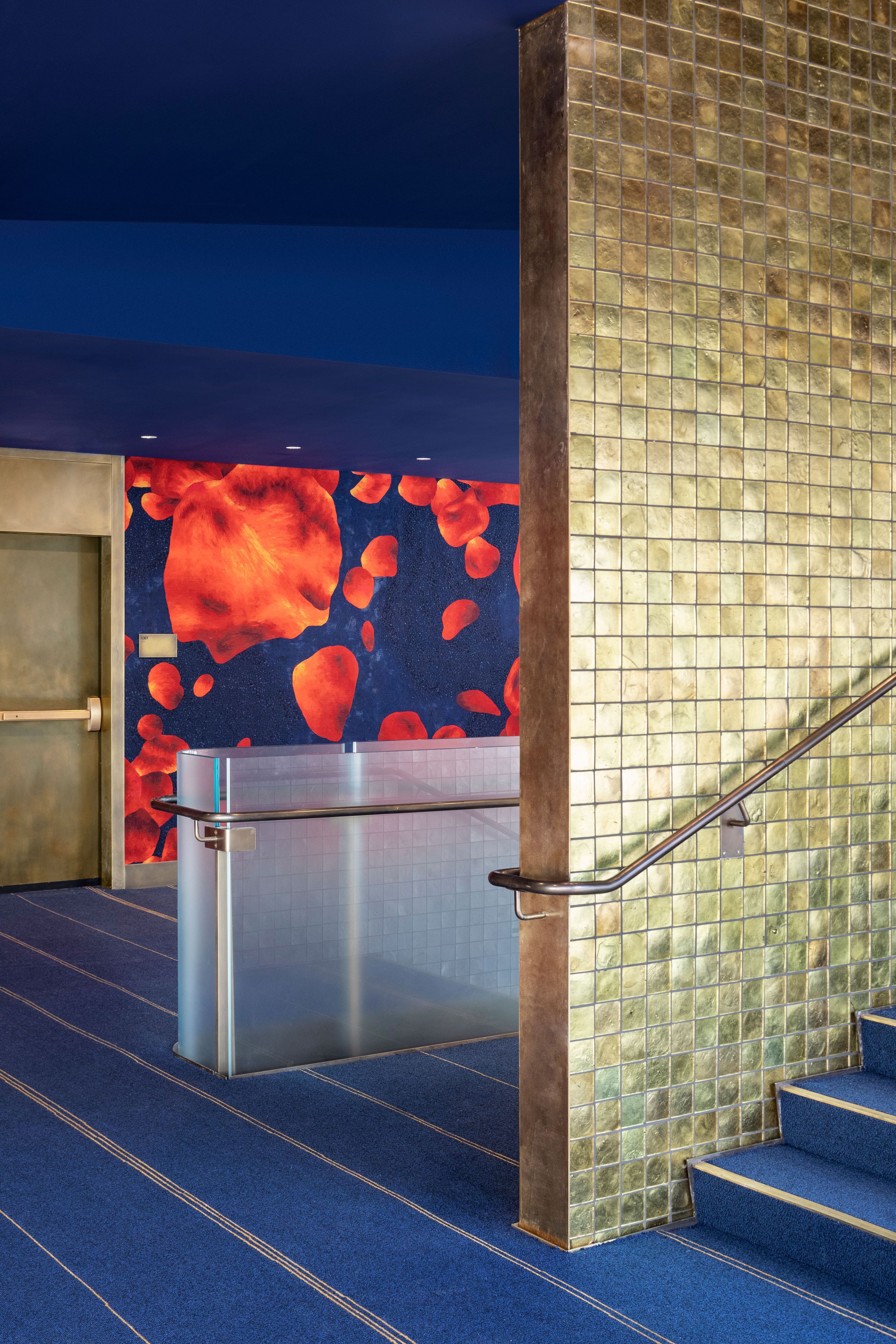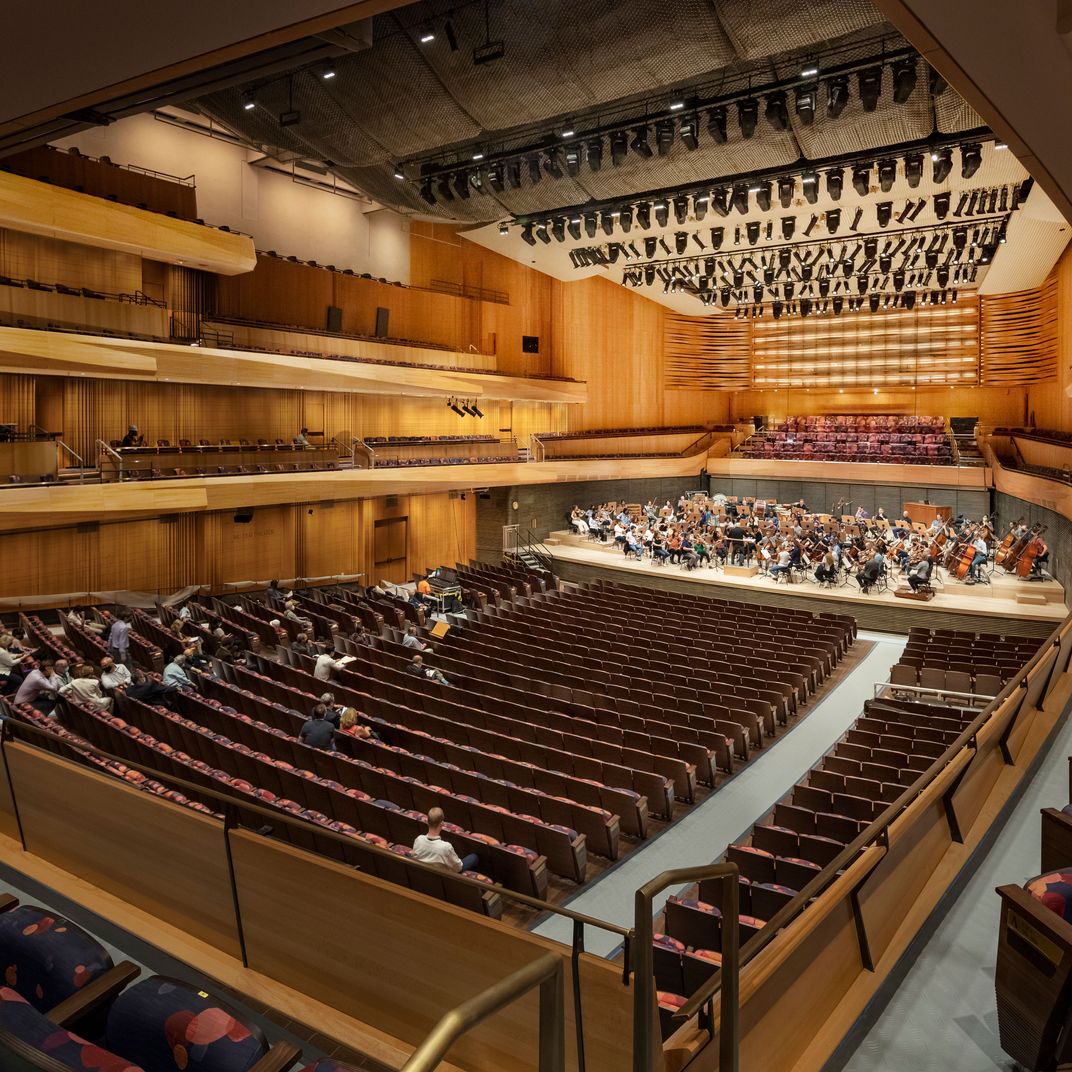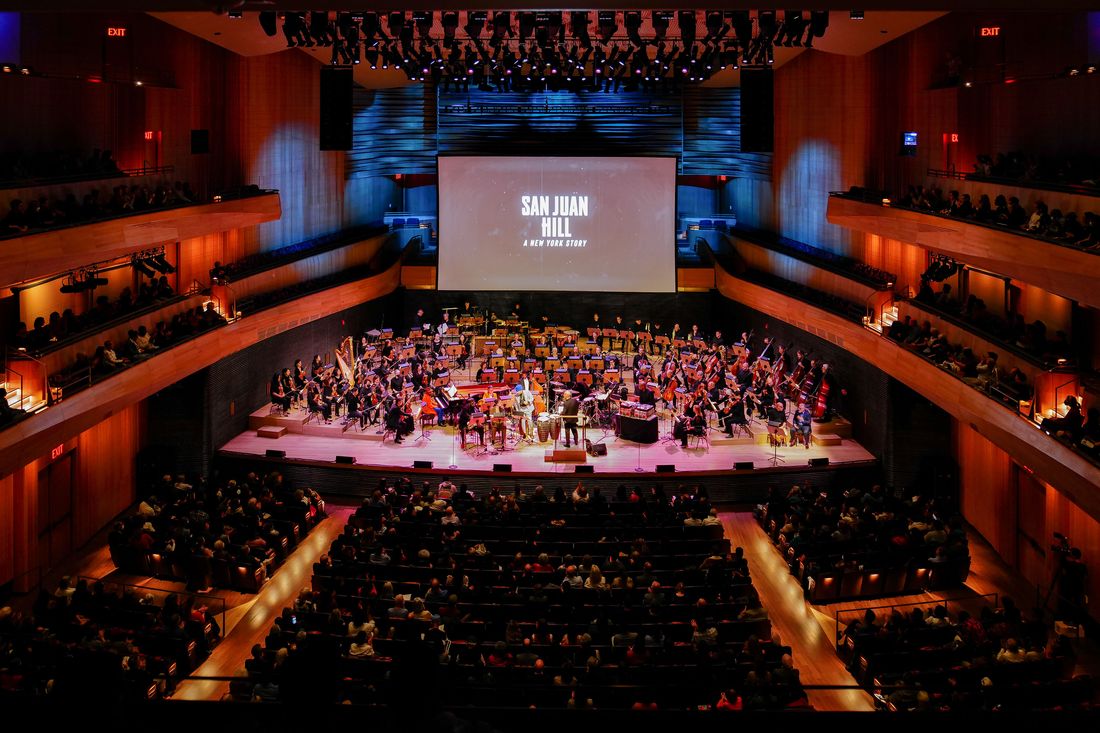
Sixty years after the grandly disappointing opening of Philharmonic Hall, 50 since it was first overhauled in a failed attempt to improve the acoustics, 30 since the second stab at fixing what was by then Avery Fisher Hall (another failure), and 18 since the planning began for a third go, the New York Philharmonic’s home, now David Geffen Hall, has finally reopened. This time around, there were no half or even three-quarter measures: The structure has had its insides scooped out and a fresh set reinstalled, packing an almost entirely new building around its skeleton and inside its shell. This afternoon, opening day, first-timers and listeners who remembered its old sound — brash and overbearing in some spots, muffled and distant in others — came primed to judge the acoustics. Did the complicated box of the auditorium allow the orchestra’s layers to remain distinct yet bound in a colorful tapestry of sound? Did the music enfold audiences rather than blare at them from afar?
The results from the first noises were provisionally encouraging and firmly inconclusive. First up was Etienne Charles’s jazz combo — the balance of his trumpet with flute, sax, drums, piano, electric guitar, and upright bass regulated by an offstage sound engineer. At least from my seat in the orchestra (Row V, left aisle), the sound was mostly clear, focused, and vivid but not steely. Then the New York Philharmonic and its music director, Jaap van Zweden, filed on to join the group for the premiere of Charles’s San Juan Hill: A New York Story, a suite composed to evoke the dense, multiethnic neighborhood that was razed to make way for Lincoln Center itself. “Know where you are and what was there before,” the bandleader said from the stage: a maxim that deserves a chorus of amens, especially from anyone with a historical appreciation for New York. But also: Inaugurating the room with music nobody has ever heard before makes it hard to compare to previous incarnations. Mixing amplified and natural instruments defies the hall’s ability to sound ideal for either. In this case, a set of absorptive curtains lined the side walls near the ceiling, a configuration that softens artificially pumped-up sounds (and probably kept Sullivan Fortner’s piano from sounding any more biting than it did) but dulls the orchestra. When the Philharmonic plays alone, that drapery will retract.
I’m not ready to declare the hall a flop or a triumph. Acoustics are not a separate entity from the music that gets played there, which in this performance included a panoply of archival recordings, record scratches, rumbly interviews, and a whole arsenal of percussion. Sitting beneath a giant film screen where ghostly images of the vanished neighborhood merged with more recent photos, the Philharmonic seemed like the hired band at its own party, most often relegated to the status of rhythm section or fat-sound filler and only occasionally stepping into the limelight. The orchestra’s Olympian brass players got a workout, at least, and they seemed to enjoy the action so much that they sometimes sounded alarmingly intense. The strings sawed away and still wound up sounding uncharacteristically timid.
There’s no need to panic that $550 million was spent in vain. The hall could yet prove perfect. In any case, the relationship between orchestra and habitat will settle over time. Musicians must adjust to a new clarity that can be both revelatory and unforgiving. They will have to push against unfamiliar acoustical limits, go easy when the room nudges a bright sound into garishness, learn how hushed a pianissimo can be and still reach the farthest seats. In a pre-opening rehearsal of Beethoven’s Symphony No. 9 (which the Philharmonic will perform on October 28 as part of the ongoing festivities), the strings at one point sounded so assertive that they bordered on aggressive. After the break, van Zweden suggested they ease up on that same passage. “Out in the hall, it’s too loud, almost harsh,” he said, apologetically. He gave a downbeat to repeat those bars and grinned when the strings instantly mellowed. And the hall itself can adapt to its inhabitants as the acoustician Paul Scarbrough continues to tilt a reflector here or add absorbent materials there. On a violin, a millimetric slip of a finger can nudge a note from unbearable to sublime; in a room, small adjustments likewise produce major variations.
The opening concert had other tasks to perform. With San Juan Hill, Lincoln Center engaged in a combination of land acknowledgement, historical record-keeping, celebration, and contrition — a sort of festival of regrets. In the 1950s, thousands of residents and hundreds of businesses were cleared away by eminent domain, displaced for this acropolis of high culture. Lincoln Center’s original sin is far from unique in American history, and it deserves to be remembered. At the same time, the opening was staged to show that the campus is a thriving and vibrant place and getting ever more so. Charles’s work offers a share of breast-beating and indictment, but mostly it’s a work of nostalgia, paging through the album of past styles — the blues, salsa, the Charleston, scraps of Gershwin and Copland — as if to remind the audience that they all belong here. Like so many such excursions into the past, each chapter made me wish I were hearing the raw original rather than its slightly hazy memory.
The new Geffen, which was unveiled two years ahead of its original construction schedule, looks much the same from the outside as it did half a billion dollars ago. Max Abramovitz’s 1962 travertine-and-glass light box, unlike almost any other building in New York, is a rectangle with four similar façades: the same templelike alternation of tapered columns and voids, the same double arcade and minimalist cornice, aspiring to an all-around desire luminosity. Before the renovation, Foster + Partners proposed tearing it down and starting from scratch. Lincoln Center instead opted at first for another plan, by Diamond-Schmitt and Thomas Heatherwick, which would have raised the roof by a story. That scheme, too, was scrapped as too costly and time-consuming. In the final version, the changes are mostly internal. Aside from a few supporting walls, the auditorium designed by Diamond Schmitt (sans Heatherwick) is an entirely new creation. Tod Williams and Billie Tsien revamped the lobby, staircases, and public areas, taking advantage of all the transparency to renegotiate the relationship between indoors and out — and between ticket-buyers and everyone else. In the crisp fall weather of opening day, a new glass garage door onto the plaza was raised, letting the breeze in and blurring the perimeter.
Williams and Tsien are experts at making small spaces feel grand and large ones intimate. The lobby is far more generous and welcoming than it used to be. The bank of DMV-style box-office windows is gone, revealing Abramovitz’s once-hidden row of thick-thighed columns that taper gracefully toward the floor. The combination of low ceiling (by today’s soaring standards) and expansive floor area that spills out onto the plaza through a glass wall creates a measure of institutional warmth. The hope is that this ample room will become an all-hours hangout with free Wi-Fi, furniture that demands to be slouched in, and that most radical of all public amenities: public bathrooms that remain open all day.
Central to that ambition is an immense screen, 50 feet long, that, starting at the end of the month, will carry the concerts taking place inside. A ring of speakers mounted in the ceiling semi-confines the music to an invisible cylinder of sound. Those who want to listen can step inside; those outside the magic circle can carry on chatting and sipping while Bruckner rumbles in the background. I have my doubts about this feature, which strikes me as one of those desperately un-with-it things classical-music organizations do to seem hip. The big lobby TV, always effervescing away with bespoke digital art, has become a fixture of skyscraper lobbies, a shrine to digital supremacy. Screens shift the burden of excitement away from architecture, which is so rarely up to the task, and gives all those high ceilings and long walls a visible purpose. All those indoor LED billboards, like the one in the Salesforce building in San Francisco, rarely seem worth the pixels. By installing one, Lincoln Center has set itself a major programming challenge for all those non-concert hours: how to make its mega-display feel more cultural than corporate.
The architects aren’t relying on that. Instead, they’ve tricked out the lobby with comforts like a bar, an adjoining restaurant (occupying a prime windowed corner and not, as before, squeezed into a dim hallway), and an information-and-ticket lounge-cum-coffee bar with a jittery electronic pattern playing on the wall. The new design amps up the theatricality of the old one. Williams and Tsien have bumped out the upper balcony level at both ends, creating platforms that overlook the audience at intermission like viewpoints in a national park. (One casualty of that move was Richard Lippold’s suspended sculpture Orpheus and Apollo, which was evicted in 2014 and will soon reappear at La Guardia Airport.) Each of those loft areas, dramatically suspended from the ceiling, is big enough for a chamber-music ensemble and a small audience in folding chairs; I’d love to hear a pair of antiphonal brass ensembles, one on each heavenly balcony, dropping Gabrieli from on high.
As you move around the building’s edges, a series of deluxe touches ennobles a space that could easily have tipped into conference-hotel blandness. In the newly public studio-cum-concert space at the building’s northeast corner, curtains made of strands of bronze chain hang before glass walls, cutting the glare. A floating staircase with bronze handrails switchbacks around a partition wall covered in iridescent square tiles — gold on one side, silver on the other. Upstairs, Williams and Tsien have revived the hovering planes of blue that they used in the LeFrak Center ice-skating rink in Prospect Park; here, the color, scored with dots of light, brings a welcome splash of darkness to an environment that used to be blindingly beige. One long wall is upholstered in a magnified version of the falling-rose-petal pattern that covers the seats in the auditorium. The cumulative effect of these flourishes is to suggest that the people who designed, paid for, and built this project all cared about quality and workmanship — not something to be taken for granted. Concertgoers tend to march through these interstitial spaces on their way to their seats or maneuver through crowds at intermission; the new design gives these spaces just enough allure for them to become rooms in their own right.
Entering the auditorium is like revisiting a city you knew in childhood and discovering that nothing is quite as you remember. The colors are brighter, the lines more sinuous yet sharper. Distances that once seemed endless have contracted. You go through a door that didn’t used to exist and find people milling around areas that had once been mysterious and abandoned. The stage has moved 25 feet forward, shortening the distance to the farthest seats, and the first-tier balcony now envelops the stage so that audience members can sit behind the double basses, as if they had joined the ensemble.
These flourishes are engineered to flatter the sounds emanating from the stage. Scarbrough, the acoustician, laid down the rules and had the final word: If a proposal deflected from the pursuit of the perfect sound, it was out. So the wood-covered walls wrinkle and fold, as if a wave moving across through the room had been trapped mid-shudder. Balconies curve and dip like ripples on a lake.
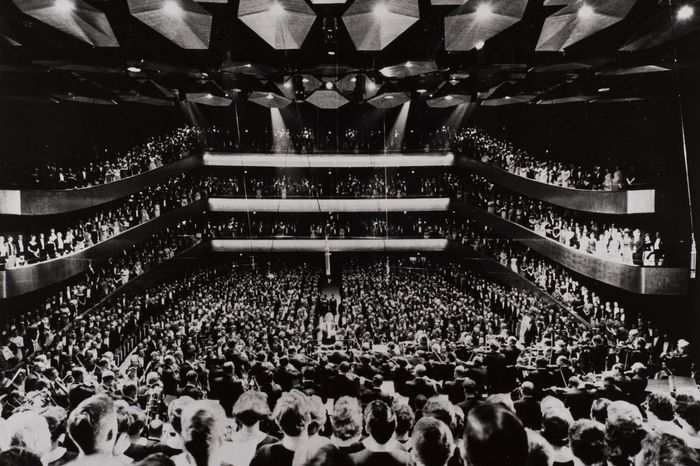
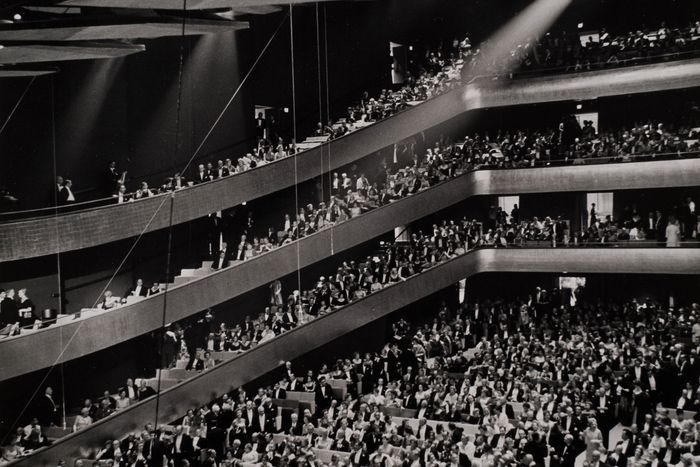
The stage is divided into segments that can be separately raised or lowered at the touch of a button, so the Philharmonic can produce multilevel theatrical productions without having to erect temporary scaffolding at exorbitant cost. Different-size ensembles get different amounts of real estate, and the separation between audience and performers can be adjusted. Seats are slightly offset from row to row, so you can even see past the tall man with the big hair. A wall of bentwood slats disguises a bank of speakers — the electronic substitute for a real pipe organ. (The hall had one but lost it in 1976.) Before each concert, a swarm of LED firefly lights descends from the ceiling, does a little dance, then ascends into the rafters and goes out. At the opening concert, the move prompted the auditorium’s first bout of applause. But that’s as flamboyant as the auditorium gets. Diamond Schmitt, a Canadian firm that values pragmatism over revolution, threaded the design with class and politesse, unwilling to distract from the show.
Even so, all this restraint yields a stealth countercultural artifact designed to receive the energy produced by the passage of air from a player’s lungs through a tube, the vibration of horsehair on string, the impact of felt on steel and skin. Our sound world is as permeated by machinery and amplification as our visual field is by electric light. Every preacher, subway busker, politician, tour guide, and Broadway actor uses a microphone; virtually every note of music we hear, whether via earbuds or in a stadium, comes to us as an electronic packet. Our homes ding, buzz, beep, and blurt. You have to get pretty far from civilization before the hubbub of chainsaws, lawnmowers, car horns, helicopters, and airplanes fades away. Amid all this power-boosted din, the concert hall is a natural-sound preserve. That doesn’t make it a quiet place. An orchestra at full churn is loud, producing wave on wave swirling off the walls and juddering through the body, making the act of listening a multisensory experience. Over time, Geffen Hall will be judged by the nuances of this tumult: how well the ear can distinguish its elements, the balance of bass and treble or winds and strings, the vividness of a crescendo. Equally crucial is the quality of quiet.
There’s a catch: Amplified music has to sound rich, round, and present. That’s never an easy balancing act, because natural instruments need reflections and reverberations; amplification systems push sound out directly to the ear and require fabric to absorb all that energy so that it doesn’t go caroming around the room, becoming muddy along the way. The oversize performing-arts centers of the 1960s and ’70s (including Lincoln Center and the Kennedy Center) aspired to total versatility, and many of those so-called multiuse venues turned out to be multiuseless — with acoustics that were equally mediocre for all genres and built-in technology that was almost immediately obsolete. (The first version of Philharmonic Hall was hardwired for television broadcast — in black and white only.) Even in recent buildings, the tension between classical and amplified music can be a killer. Philharmonic president Deborah Borda, who ran the Los Angeles Philharmonic from 2000 to 2017, recalls with a grimace the time in 2003 when Keith Jarrett first performed at L.A.’s then-new Disney Hall. Deeply unhappy with the acoustics, he grumbled that “it was like being in the center of a big bowl with the sound stirring around and never finding any sort of focus.” So much attention had gone into achieving the perfect environment for classical instruments that the amps produced an unpleasant brown murk. (Disney Hall’s acoustics have since been adjusted, and Jarrett has played there again, reportedly with pleasure.) Borda vowed not to make that mistake again. For Geffen Hall, Scarbrough developed a series of preset configurations for the hall’s varying demands.
The new lobby, with its immense LED screen.
Blue and gold detailing by Tod Williams Billie Tsien.
The auditorium.
The new lobby, with its immense LED screen.
Blue and gold detailing by Tod Williams Billie Tsien.
The auditorium.
Those needs are constantly changing — more urgently now in the wake of the pandemic and several years of social upheaval. The ability to host small gatherings and big galas, to mount informal performances as well as high-tech blowouts, gives Lincoln Center more technical resources to live up to its growing aspirations. “Any organization that behaves in 2022 exactly as they did in 2018 and expects the same results is going to be disappointed,” says Lincoln Center president Henry Timms. “There have been fundamental shifts.” That’s one reason to open the hall with the new work about San Juan Hill. A year ago, the umbrella organization that both manages the campus and produces its own events (fondly known as “Linc., Inc.” to distinguish it from the center’s many other constituent organizations) hired Shanta Thake as artistic chief to navigate those shifts. She has already put her stamp on the campus with eclectic outdoor programming over the summer. The annual Brooklyn Afropunk festival will come to Geffen Hall for a weekend early next year; so will Europe’s majority Black and ethnically diverse Chineke! Orchestra, the only visiting symphonic ensemble to be invited onto the new stage this season. The hall’s opening acts as a gateway to a performing-arts center that hopes to be many more things to many more people.
That aspiration was there from the beginning. John D. Rockefeller III, who was instrumental in the establishment of Lincoln Center, provided its foundational philosophy: “The arts are not for the privileged few but for the many. Their place is not on the periphery of daily life but at its center,” he said. (A plaque inscribed with those words hangs on a wall near the Vivian Beaumont Theater.) Still, the institution has never quite relinquished its reputation as a haven of elitism, where fine artists play to connoisseurs at high prices in an atmosphere of precious hush. That perception hasn’t been fair for many years, but the challenge of how to be contemporary and democratic while prizing tradition (and remaining solvent) must be faced again and again. “It’s not a problem that we’re still asking that question,” says Lincoln Center president Henry Timms. “We should be asking it always.”



